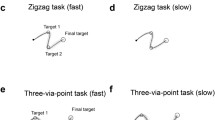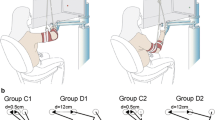Abstract
Our sensory-motor control system has a remarkable ability to adapt to novel dynamics during reaching movements and generalizes this adaptation to movements made in different directions, positions and even speeds. The degree and pattern of this generalization are of great importance in deducing the underlying mechanisms that govern our motor control. In this report we expand our knowledge on the generalization between movements made at different speeds. We wished to determine the pattern of generalization between different speed and duration movements on a trial-by-trial basis. In addition, we tested three hypotheses for the pattern of generalization. The first hypothesis was that the generalization was maximum for the speed of the movement just made with a linear decrease in generalization as one moves away from that preferred speed. The second was that the generalization is always highest for the fastest speed movements and linearly decreases with speed. The last hypothesis came from our preliminary results, which suggested that the generalization plateaus. Human subjects made targeted reaching movements at four different maximum speeds (15, 35, 55 and 75 cm/s) presented in pseudorandom order to one spatial target (15 cm extent) while holding onto a robotic manipulandum that produced a viscous curl field. Catch trials (trial where the curl field was unexpectedly removed) were used to probe the generalization between the four speed/durations on a movement-by-movement basis. We found that the pattern of generalization was linear between the first three speed categories (15–55 cm/s), but plateaued after the 55 cm/s category. We compared the subjects’ results with a simulated adaptive controller that used a population code by combining the output of basis elements. These basis elements encoded limb velocity and associated this with a force expectation at that velocity. We found that using a basis set of Gaussians the adaptive controller produced movements that generalized in virtually the exact manner as the subjects, as we have previously demonstrated for movements made to different spatial targets. Thus, the human internal model may employ such a population code.








Similar content being viewed by others
References
Bock O, Thomas M, Grigorova V (2005) The effect of rest breaks on human sensorimotor adaptation. Exp Brain Res 163:258–260
Churchland MM, Santhanam G, Shenoy KV (2006) Preparatory activity in premotor and motor cortex reflects the speed of the upcoming reach. J Neurophysiol 96:3130–3146
Donchin O, Shadmehr R (2004) Change of desired trajectory caused by training in a novel motor task. Conf Proc IEEE Eng Med Biol Soc 6: 4495–4498
Donchin O, Francis JT, Shadmehr R (2003) Quantifying generalization from trial-by-trial behavior of adaptive systems that learn with basis functions: theory and experiments in human motor control. J Neurosci 23: 9032–9045
Evarts EV (1968) Relation of pyramidal tract activity to force exerted during voluntary movement. J Neurophysiol 31:14–27
Flash T, Hogan N (1985) The coordination of arm movements: an experimentally confirmed mathematical model. J Neurosci 5:1688–1703
Francis JT (2005) Influence of the inter-reach-interval on motor learning. Exp Brain Res 167:128–131
Franklin DW, Osu R, Burdet E, Kawato M, Milner TE (2003) Adaptation to stable and unstable dynamics achieved by combined impedance control and inverse dynamics model. J Neurophysiol 90:3270–3282
Fu QG, Suarez JI, Ebner TJ (1993) Neuronal specification of direction and distance during reaching movements in the superior precentral premotor area and primary motor cortex of monkeys. J Neurophysiol 70: 2097–2116
Gandolfo F, Mussa-Ivaldi FA, Bizzi E (1996) Motor learning by field approximation. Proc Natl Acad Sci USA 93:3843–3846
Georgopoulos AP, Kalaska JF, Caminiti R, Massey JT (1982) On the relations between the direction of two-dimensional arm movements and cell discharge in primate motor cortex. J Neurosci 2:1527–1537
Georgopoulos AP, Kettner RE, Schwartz AB (1988) Primate motor cortex and free arm movements to visual targets in three-dimensional space. II. Coding of the direction of movement by a neuronal population. J Neurosci 8:2928–2937
Goodbody SJ, Wolpert DM (1998) Temporal and amplitude generalization in motor learning. J Neurophysiol 79:1825–1838
Gribble PL, Mullin LI, Cothros N, Mattar A (2003) Role of cocontraction in arm movement accuracy. J Neurophysiol 89:2396–2405
Harris CM, Wolpert DM (1998) Signal-dependent noise determines motor planning. Nature 394:780–784
Huang VS, Shadmehr R (2007) Evolution of motor memory during the seconds after observation of motor error. J Neurophysiol 97:3976–3985
Kitazawa S, Kimura T, Uka T (1997) Prism adaptation of reaching movements: specificity for the velocity of reaching. J Neurosci 17: 1481–1492
Kording KP, Fukunaga I, Howard IS, Ingram JN, Wolpert DM (2004) A neuroeconomics approach to inferring utility functions in sensorimotor control. PLoS Biol 2:e330
Krouchev NI, Kalaska JF (2003) Context-dependent anticipation of different task dynamics: rapid recall of appropriate motor skills using visual cues. J Neurophysiol 89:1165–1175
Lackner JR, Dizio P (1994) Rapid adaptation to Coriolis force perturbations of arm trajectory. J Neurophysiol 72:299–313
Moran DW, Schwartz AB (1999) Motor cortical representation of speed and direction during reaching. J Neurophysiol 82:2676–2692
Nakano E, Imamizu H, Osu R, Uno Y, Gomi H, Yoshioka T, Kawato M (1999) Quantitative examinations of internal representations for arm trajectory planning: minimum commanded torque change model. J Neurophysiol 81: 2140–2155
Osu R, Kamimura N, Iwasaki H, Nakano E, Harris CM, Wada Y, Kawato M (2004) Optimal impedance control for task achievement in the presence of signal-dependent noise. J Neurophysiol 92:1199–1215
Pouget A, Snyder LH (2000) Computational approaches to sensorimotor transformations. Nat Neurosci 3(Suppl):1192–1198
Scheidt RA, Dingwell JB, Mussa-Ivaldi FA (2001) Learning to move amid uncertainty. J Neurophysiol 86:971–985
Shadmehr R, Mussa-Ivaldi FA (1994) Adaptive representation of dynamics during learning of a motor task. J Neurosci 14:3208–3224
Shadmehr R, Donchin O, Hwang EJ, Hemminger SE, Rao A (2005) Learning dynamics of reaching. CRC, Boca Raton
Thoroughman KA, Shadmehr R (2000) Learning of action through adaptive combination of motor primitives [see comments]. Nature 407:742–747
Uno Y, Kawato M, Suzuki R (1989) Formation and control of optimal trajectory in human multijoint arm movement. Minimum torque-change model. Biol Cybern 61:89–101
Acknowledgments
I would like to thank Reza Shadmehr for the use of his manipulandum as well as helpful conversation and Sarah Hemminger for proofreading of the manuscript. This work was supported by NIH 2-R01-NS037422 to RS.
Author information
Authors and Affiliations
Corresponding author
Rights and permissions
About this article
Cite this article
Francis, J.T. Error generalization as a function of velocity and duration: human reaching movements. Exp Brain Res 186, 23–37 (2008). https://doi.org/10.1007/s00221-007-1202-y
Received:
Accepted:
Published:
Issue Date:
DOI: https://doi.org/10.1007/s00221-007-1202-y




